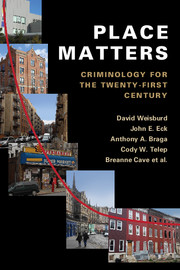Book contents
- Frontmatter
- Contents
- List of figures
- List of tables
- List of contributors
- Preface
- 1 Crime Places within Criminological Thought
- 2 The Concentration of Crime at Place
- 3 Theories of Crime and Place
- 4 The Importance of Place in Mainstream Criminology and Related Fields: Influences and Lessons to be Learned
- 5 Methods of Place-Based Research
- 6 Reducing Crime at High-Crime Places: Practice and Evidence
- 7 Crime Places in the Criminological Imagination
- Notes
- References
- Index
- References
References
Published online by Cambridge University Press: 05 April 2016
- Frontmatter
- Contents
- List of figures
- List of tables
- List of contributors
- Preface
- 1 Crime Places within Criminological Thought
- 2 The Concentration of Crime at Place
- 3 Theories of Crime and Place
- 4 The Importance of Place in Mainstream Criminology and Related Fields: Influences and Lessons to be Learned
- 5 Methods of Place-Based Research
- 6 Reducing Crime at High-Crime Places: Practice and Evidence
- 7 Crime Places in the Criminological Imagination
- Notes
- References
- Index
- References
Summary

Information
- Type
- Chapter
- Information
- Place MattersCriminology for the Twenty-First Century, pp. 163 - 196Publisher: Cambridge University PressPrint publication year: 2016
